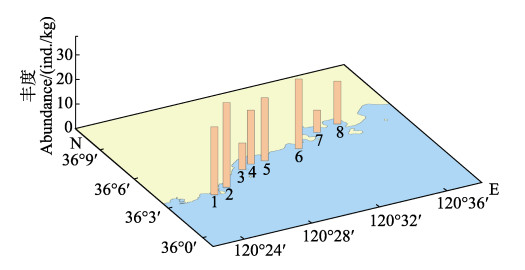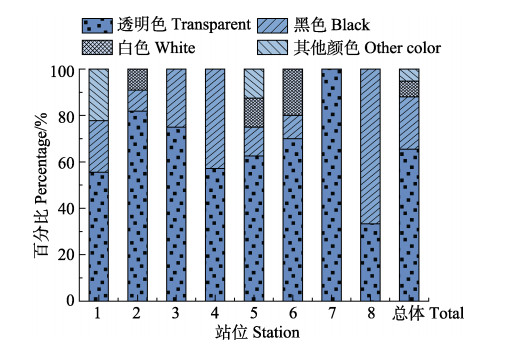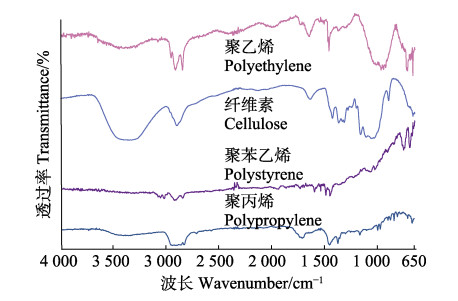2. 海水养殖生物育种与可持续产出全国重点实验室 中国水产科学研究院黄海水产研究所 山东 青岛 266071;
3. 海洋生态与环境科学功能实验室 山东 青岛 266237
2. State Key Laboratory of Mariculture Biobreeding and Sustainable Goods, Yellow Sea Fisheries Research Institute, Chinese Academy of Fishery Sciences, Qingdao 266071, China;
3. Marine Ecology and Environmental Science Laboratory, Qingdao 266237, China
随着塑料制品的大量生产使用,不可避免地产生大量塑料垃圾,其中尺寸小于5 mm的塑料颗粒被定义为微塑料(Thompson et al, 2004)。根据来源不同,微塑料可分为初生微塑料和次生微塑料(Wang et al, 2018)。初生微塑料指工业生产中制备的粒径小于5 mm的塑料颗粒,如磨砂膏、牙膏、洗面奶中的塑料微珠(Carr et al, 2016; Farrell et al, 2013);次生微塑料指由大型塑料物品经机械磨损、紫外辐射和生物破碎等作用形成的塑料微粒(Barnes et al, 2009; Salvador Cesa et al, 2017)。调查表明,微塑料已经遍布全球不同海域,被形象地称为“海洋中的PM2.5”(Amelia et al, 2021; 陈舒, 2018; 刘香等, 2021; Peng et al, 2018)。微塑料作为倍受全球关注的新污染物,已成为与全球气候变化、臭氧耗竭和海洋酸化并列的重大全球环境问题,其污染特征及生态环境风险已成为全球研究热点。海洋微塑料主要来源于大气沉降、陆源输入、滨海旅游、海上航运、渔业生产活动等(夏斌等, 2019)。其中,海底沉积物又被认为是海洋中微塑料的“汇”(Xue et al, 2020)。沉积物中不仅沉积大量有机质(聂梦晨等, 2022),还是水环境中多种污染物的载体(杨帆等, 2022),微塑料沉降到沉积物中受到水力条件等的影响会再次移动(Kumar et al, 2021; 周志文等, 2023)。青岛沉积物类型较为复杂,有粘土质粉砂、砂质粉砂和粉砂等。研究发现,近岸沙滩、近海沉积物及深远海沉积物中均存在不同丰度的微塑料污染。城市近岸海域往往是高强度人类活动区域,其海底沉积物中微塑料的污染状况可能更为复杂。但至今为止,城市近岸海域沉积物中微塑料的污染现状和分布特征仍不清楚,亟待研究。
本研究以典型滨海旅游和海洋城市青岛市为例,对其崂山近岸海域表层沉积物中微塑料的丰度、形状、聚合物类型和颜色等进行调查研究,以期阐明青岛市崂山近岸海域沉积物中微塑料的污染现状和分布特征,为城市近岸海域微塑料生态环境风险评估和管控提供科学参考。
1 材料与方法 1.1 调查时间与调查站位2023年3月6日在山东省青岛市崂山近岸海域共设置8个调查站位(图 1)。其中,1、2号站位位于麦岛湾,附近分布有小麦岛公园等旅游景点,但2号站位附近有污水处理厂(青岛水务排水公司第四排水分公司)排放口;3、4、5号站位位于大江口湾,附近分布有青岛雕塑园、石老人海水浴场等旅游景点;6号站位位于鹁鸽窝,附近主要是居民区;7、8号站位位于沙子口湾,附近分布有青岛沙子口国家中心渔港,并有南九水河流入。站点附近有多种人类活动方式,其中,1号取样点为旅游景区,2号为污水处理厂,3、4、5号取样点为海水浴场,6号为居民区,7、8号为河流入海口和渔港。

|
图 1 调查站位示意图 Fig.1 Distribution of sampling sites |
使用德国HYDRO-BIOS公司的Van Veen采泥器,采集表层约5 cm的海底沉积物,将采集的沉积物样品装入铝箔袋中,立即置于装有冰袋的保温箱中2~8 ℃保存,随后带回实验室分析。
1.3 样品处理每个站位称取约300 g沉积物样品,放入烘箱中干燥至恒定重量。干燥完成后,称取100 g干燥沉积物样品置于玻璃烧杯中,加入1 000 mL饱和NaCl溶液,用玻璃棒预搅拌后,放入磁力转子搅拌24 h,确保充分悬浮微塑料。随后静置12 h,收集上清液至干净的玻璃烧杯中备用。随后,重复上述悬浮过程3次,确保全部微塑料悬浮至上清液中。使用玻璃纤维膜过滤上清液,并用蒸馏水反复洗涤以去除NaCl。用30%的H2O2溶液将膜上的固体全部冲至玻璃烧杯中,并加入催化剂FeCl2消解有机物。静置沉淀24 h后,用真空抽滤装置和53 μm滤膜过滤上清液,取下滤膜,并将滤膜上“微塑料”样品转移至玻璃培养皿中进行下一步观察。
1.4 微塑料鉴定将得到的“微塑料”样品放置在光学显微镜(Olympus BX-51,日本)下观察,挑选出疑似微塑料颗粒并记录其数量、尺寸、形状和颜色等信息。微塑料尺寸分为<0.5 mm、0.5~1 mm、1~2 mm、2~3 mm、3~4 mm和4~5 mm;形状分为颗粒状、纤维状和薄层状;颜色分为透明色、黑色、白色和其他颜色。使用傅里叶变换红外显微镜(micro-FTIR, Thermo Fisher Nicolet iN10, 美国)鉴定疑似微塑料的化学聚合物类型,并在傅里叶变换红外显微镜下拍照,具体操作方法参照Zhu等(2018)。将获得的光谱图与OMNIC标准光谱库进行比对,确定微塑料的聚合物类型。匹配度阈值设定为70%,即仅当匹配度高于70%时,才可认定疑似微塑料为微塑料(Yang et al, 2015)。
1.5 数据处理与图表绘制微塑料丰度表示为每千克干重沉积物中微塑料的个数(ind./kg)。使用Arcgis 10.8软件绘制调查站位图,使用Origin 2022软件进行数据统计分析与图表绘制。
1.6 质量控制在进行沉积物中微塑料的提取和分析过程中,采取相关预防措施防止样本受到外部塑料污染。所有玻璃容器均经过稀硝酸浸泡过夜,随后用去离子水冲洗至少3次。化学溶液在使用前均通过0.45 μm的玻璃纤维膜过滤。在进行显微镜检查之前,关闭实验室的所有门窗,防止人员走动,最大程度地减少空气污染。在现场取样和分析过程中,穿戴棉布衣服,佩戴丁腈手套和纯棉口罩,确保分析过程中无塑料污染。
2 结果与讨论 2.1 微塑料丰度如图 2所示,青岛市崂山近岸海域8个调查站位海底沉积物中均检测到微塑料,微塑料丰度范围为9.06~ 34.48 ind./kg,平均丰度为(21.97±8.32) ind./kg。微塑料丰度按照由大到小排序依次为2号站位(34.48 ind./kg) > 6号站位(28.41 ind./kg) > 1号站位(27.70 ind./kg) > 5号站位(25.72 ind./kg) > 4号站位(22.01 ind./kg) > 8号站位(17.54 ind./kg) > 3号站位(10.87 ind./kg) > 7号站位(9.06 ind./kg)。1、2号站位都位于麦岛湾小麦岛公园附近,但2号站位微塑料丰度明显高于1号站位,原因可能是2号站位附近有市政废水处理厂(青岛水务排水公司第四排水分公司)排放口,排放的废水中可能含有未被滤除的微塑料颗粒,其逐渐沉降埋藏于周围海域海底沉积物中。6号站位微塑料丰度也较高,仅次于2号站位,原因可能是6号站位附近分布有大量居民区,衣物洗涤等居民日常活动产生的大量塑料纤维随生活废水进入周围海域。7、8号站位位于沙子口湾,附近分布有青岛沙子口国家中心渔港,人类活动频繁,特别是7号站位附近还有南九水河流入,但是,2个站位海底沉积物中微塑料丰度相对其他站位整体较低,这可能与中心渔港港池和航道疏浚清淤有关。受冲淤等因素影响,港池和航道海底的淤泥逐年增多,水深越来越浅,达不到船舶设计吃水深度,无法保证船舶安全通行和停泊需求,必须定期进行疏浚清淤,将一定深度的海底表层沉积物移走,在此过程中,沉积物中微塑料颗粒也一同被移走。

|
图 2 沉积物中微塑料的丰度 Fig.2 Abundance of microplastics in sediments |
青岛市崂山近岸海域沉积物中微塑料丰度与国内外部分海域沉积物对比见表 1。与青岛6个海水浴场沉积物中的微塑料平均丰度[(17.88±5.18) ind./kg] (Gao et al, 2021)和青岛胶州湾沉积物中的微塑料平均丰度[(25.00±3.10) ind./kg] (Zheng et al, 2020)相比,青岛市崂山近岸海域沉积物中的微塑料平均丰度基本处于同一水平,说明青岛城市近岸海域沉积物中微塑料的丰度整体一致。与国内北黄海(Zhu et al, 2018)、南黄海(Zhao et al, 2018)及广东东部近海(Chen et al, 2023)等相比,青岛市崂山近岸海域沉积物中的微塑料丰度处于相对较低水平。与国外爱尔兰近海(Mendes et al, 2021)和波罗的海(Zobkov et al, 2017)沉积物相比,青岛市崂山近岸海域沉积物中的微塑料丰度处于相对较低水平,与法国北部海域(Doyen et al, 2019)和新西兰近海(Clunies-Ross et al, 2016)基本处于同一水平。海洋沉积环境受到人类活动方式、地形及水体动力学等多方面因素的影响。取样方法和鉴定方法的不同也会影响微塑料丰度及其特征的研究结果。崂山近岸海域人类活动多以旅游、排放生活污水和近海捕鱼活动为主,沙滩、海水浴场及渔港的定时清理避免了大型塑料在光照和海水等作用下降解成微塑料的风险。因此,与上述区域相比,青岛市崂山近岸海域沉积物中微塑料污染水平整体处于中下等水平。
|
|
表 1 国内外部分海域沉积物中微塑料丰度 Tab.1 Abundance of microplastics in sediments from some regions in China and abroad |
如图 3所示,本次调查崂山近岸海域海底沉积物中主要是粒径小于0.5 mm的微塑料,其占比最高(76%);其次是粒径在0.5~1 mm之间的微塑料,其占比为14%。本次调查未检出3~ 4 mm和4~5 mm粒径的微塑料,检出的微塑料最大粒径为2~3 mm,但其含量占比较少。特别是3、7号站位的海底沉积物中检出的微塑料粒径均小于0.5 mm。这些结果表明,海底沉积物中较小粒径的微塑料丰度明显高于较大粒径的微塑料,该现象与Tang等(2018)的研究结果一致。研究表明,海洋中的微塑料以小粒径为主。例如,天津近岸海域、渤海及黄海近海中检出的微塑料粒径主要分布于0.5 mm以下(韩龙等, 2022; Zhao et al, 2018)。但受采样方法和过滤装置孔径的限制,目前只能检测到一定粒径之上的微塑料。例如,本研究使用的是53 μm孔径的滤膜,只能收集并检出粒径大于53 μm的微塑料。因此,海洋中实际存在的大量小粒径微塑料甚至纳米塑料的污染状况可能被远远低估,人们对其的认识仍有待加强(Cai et al, 2018)。研究表明,相比于大粒径微塑料,粒径越小的微塑料越容易穿透生物屏障,随血液循环迁移至生物体的不同组织,从而对海洋生物造成更严重的毒性效应(Li et al, 2021; 张国旗等, 2024)。因此,基于海洋微塑料污染调查数据对微塑料的海洋生态风险进行评估时,需要充分考虑被遗漏的小粒径微塑料对海洋生态环境的潜在风险,下一步要加强小粒径微塑料特别是纳塑料的采集、分离和检测技术研发。

|
图 3 各站位沉积物微塑料的粒径分布 Fig.3 Particle size distribution of microplastics in sediments at different sites |
如图 4所示,本次调查崂山近岸海域海底沉积物中检测出的微塑料形状以颗粒状、纤维状和薄层状为主,其中,纤维状含量最高,占比53%,且8个调查站位均有检出;其次为颗粒状,占比33%,除4号站位外,其余7个站位均有检出;剩余为薄层状,占比14%,有5个站位检出。初生微塑料一般为球形等较规则的形状,而本次调查检出的微塑料为颗粒状、纤维状和薄层状等3种不规则形状,且主要为纤维状,可见调查区域海底沉积物中的微塑料主要为次生微塑料。Browne等(2011)研究发现,一件衣服单次洗涤就会释放至少1 900根纤维状微塑料。因此,家庭衣物洗涤可能是调查区域海底沉积物中微塑料的主要来源之一。另外,塑料网具和绳索等破碎和分解可能也是调查区域海底沉积物中微塑料的来源之一。纤维状微塑料容易弯曲缠绕或粘附于食物表面,增加被海洋生物摄入体内的概率,且生物体内纤维状微塑料的排出速度慢、停留时间长。而调查区域海底沉积物中微塑料以纤维状为主,因此,本区域的底栖海洋生物体内可能蓄积的主要是纤维状微塑料。

|
图 4 各站位沉积物微塑料的形状分布(A)和不同形状微塑料的显微表征(B) Fig.4 Shape distribution of microplastics in sediments at different sites (A) and characterization of different shapes of microplastics (B) |
如图 5所示,本次调查微塑料的颜色以透明色为主,占比66%;其次是黑色,占比22%,白色和其他颜色微塑料占比较少,分别为7%和5%。各调查站位中均检出透明色微塑料,在7号站位中透明色微塑料占比最高(100%)。除7号站位外,其余站位均检出了黑色微塑料。根据微塑料的形状特征可以发现,调查区域沉积物种的微塑料主要为次生微塑料。因此,调查区域沉积物中微塑料颜色以透明色为主,可能是塑料在破碎和分解转化为微塑料颗粒的过程中受光辐射等影响导致逐渐褪色所致。另外,还可能与海洋生物摄入水体中的有颜色微塑料,致使有颜色微塑料向沉积物沉降和埋藏减少有关。例如,有些鱼类属于视觉捕食者,主要依赖颜色和光线等特征辨别食物(Wright et al, 2013),因此,微塑料的颜色会误导鱼类的摄食行为。鱼类甚至会对特定颜色的微塑料表现出摄食偏好性(Okamoto et al, 2022),尽管不同海洋鱼类对颜色的摄食偏好强度存在差异,但都偏好摄入有颜色的微塑料(Chenet et al, 2021; Morgan et al, 2021; Renzi et al, 2019)。因此,水体中有颜色的微塑料可能已被鱼类等海洋生物摄食,导致其向沉积物沉降和埋藏量减少。

|
图 5 各站位沉积物中微塑料的颜色分布 Fig.5 Color distribution of microplastics in sediments at different sites |
如图 6和图 7所示,本次调查共检出4种聚合物类型的微塑料,包括聚丙烯(polypropylene, PP)、聚苯乙烯(polystyrene, PS)、纤维素(cellulose)和聚乙烯(polyethylene, PE)。其中,主要是聚丙烯,占比45%;其次为聚苯乙烯,占比22%,且除3号站位外其余站位均检出聚苯乙烯微塑料。据统计,目前有数百种塑料材料,其中聚乙烯、聚丙烯、聚氯乙烯(polyvinyl chloride, PVC)、聚苯乙烯和聚对苯二甲酸乙二醇酯(polyethylene terephthalate, PET)塑料被广泛应用,约占总需求的90% (Andrady, 2011)。聚丙烯微塑料在本次调查中检出率最高,因成本低、加工方便,聚丙烯被广泛用于打包袋(李思琼等, 2023)、塑料编织和薄膜包装(陈诚等, 2023)等。在麦岛湾及大江口湾附近站位海底沉积物中均检出了聚丙烯微塑料且含量较高,人类生活污水及旅游业可能是产生聚丙烯微塑料的主要来源。尹诗琪等(2021)在麦岛附近海域中检测到的微塑料成分同样主要为聚丙烯。聚苯乙烯和聚乙烯通常用于制作食品包装、寿命较短的网箱、保温泡沫箱和鱼线等塑料产品(Fahrenfeld et al, 2019),而鹁鸽窝及沙子口湾附近站位大量检出聚苯乙烯和聚乙烯微塑料,说明渔港附近海域中的微塑料可能主要来源于海鲜冷藏保鲜中使用的保温塑料泡沫箱及渔船使用的塑料渔具等制品的破碎和分解。海洋中的微塑料会吸附其他污染物,从而对海洋生物产生更强的毒性效应。但不同成分的微塑料对其他污染物的吸附能力存在较大差异。例如,与其他塑料相比,聚乙烯对大多数污染物具有更强的吸附力(Alimi et al, 2018)。因此,不同成分微塑料的海洋生态风险严重程度可能存在较大差异。

|
图 6 各站位沉积物中微塑料的聚合物成分比例 Fig.6 Polymer composition ratio of microplastics in sediment at different sites |

|
图 7 沉积物微塑料显微傅里叶红外光谱图 Fig.7 Micro-Fourier infrared spectroscopy of microplastics in the sediments |
本研究表明,青岛市崂山近岸海域沉积物中微塑料丰度处于9.06~34.48 ind./kg之间,平均丰度为(21.97± 8.32) ind./kg;微塑料主要形态为纤维状,占比53%;主要颜色为透明色,占比66%;粒径主要分布于0.5 mm以下,占比76%;聚合物类型主要为聚丙烯,占比45%。根据微塑料特征判断,调查区域沉积物中微塑料主要为次生微塑料,其污染状况和分布特征受沿岸城市人类活动影响较大。与国内外其他海域沉积物相比,青岛市崂山近岸海域沉积物中微塑料污染程度整体处于较低水平。但考虑到沿岸城市人类活动强度较大,其微塑料污染状况、分布特征需要长期关注。
ALIMI O S, FARNER BUDARZ J, HERNANDEZ L M, et al. Microplastics and nanoplastics in aquatic environments: Aggregation, deposition, and enhanced contaminant transport. Environmental Science and Technology, 2018, 52: 1704-1724 DOI:10.1021/acs.est.7b05559 |
AMELIA T S M, KHALIK W M A W M, ONG M C, et al. Marine microplastics as vectors of major ocean pollutants and its hazards to the marine ecosystem and humans. Progress in Earth and Planetary Science, 2021, 8(1): 1-26 DOI:10.1186/s40645-020-00388-2 |
ANDRADY A L. Microplastics in the marine environment. Marine Pollution Bulletin, 2011, 62: 1596-1605 DOI:10.1016/j.marpolbul.2011.05.030 |
BARNES D K A, GALGANI F, THOMPSON R C, et al. Accumulation and fragmentation of plastic debris in global environments. Philosophical Transactions of the Royal Society B: Biological Sciences, 2009, 364(1526): 1985-1998 DOI:10.1098/rstb.2008.0205 |
BROWNE M A, CRUMP P, NIVEN S J, et al. Accumulation of microplastic on shorelines woldwide: Sources and sinks. Environmental Science and Technology, 2011, 45: 9175-9179 DOI:10.1021/es201811s |
CAI M G, HE H X, LIU M Y, et al. Lost but can't be neglected: Huge quantities of small microplastics hide in the South China Sea. Science of the Total Environment, 2018, 633: 1206-1216 DOI:10.1016/j.scitotenv.2018.03.197 |
CARR S A, LIU J, TESORO A G. Transport and fate of microplastic particles in wastewater treatment plants. Water Research, 2016, 91: 174-182 DOI:10.1016/j.watres.2016.01.002 |
SALVADOR CESA F, TURRA A, BARUQUE-RAMOS J. Synthetic fibers as microplastics in the marine environment: A review from textile perspective with a focus on domestic washings. Science of the Total Environment, 2017, 598: 1116-1129 DOI:10.1016/j.scitotenv.2017.04.172 |
CHEN C, WEI H G, SUN K Y, et al. What are the factors that affect the price of polypropylene?. China Petrochemical Industry Observer, 2023(3): 60-61 [陈诚, 魏海国, 孙克乙, 等. 影响聚丙烯价格的因素有哪些. 中国石油和化工产业观察, 2023(3): 60-61] |
CHEN S. Quietly attacking "marine PM2.5". Land and Resources, 2018(11): 23-27 [陈舒. 悄然来袭的"海洋PM2.5". 国土资源, 2018(11): 23-27 DOI:10.3969/j.issn.1671-1904.2018.11.009] |
CHEN X H, ZHAO P H, WANG D F, et al. Microplastics in marine sediments in eastern Guangdong in the South China Sea: Factors influencing the seasonal and spatial variations. Water, 2023, 15(6): 1160 DOI:10.3390/w15061160 |
CHENET T, MANCIA A, BONO G, et al. Plastic ingestion by Atlantic horse mackerel (Trachurus trachurus) from central Mediterranean Sea: A potential cause for endocrine disruption. Environmental Pollution, 2021, 284: 117449 DOI:10.1016/j.envpol.2021.117449 |
CLUNIES-ROSS P J, SMITH G P S, GORDON K C, et al. Synthetic shorelines in New Zealand? Quantification and characterisation of microplastic pollution on Canterbury's coastlines. New Zealand Journal of Marine and Freshwater Research, 2016, 50: 317-325 DOI:10.1080/00288330.2015.1132747 |
DOYEN P, HERMABESSIERE L, DEHAUT A, et al. Occurrence and identification of microplastics in beach sediments from the Hauts-de-France region. Environmental Science and Pollution Research, 2019, 26: 28010-28021 DOI:10.1007/s11356-019-06027-8 |
FAHRENFELD N L, ARBUCKLE-KEIL G, NADERI BENI N, et al. Source tracking microplastics in the freshwater environment. TrAC Trends in Analytical Chemistry, 2019, 112: 248-254 DOI:10.1016/j.trac.2018.11.030 |
FARRELL P, NELSON K. Trophic level transfer of microplastic: Mytilus edulis (L.) to Carcinus maenas (L.). Environmental Pollution, 2013, 177: 1-3 DOI:10.1016/j.envpol.2013.01.046 |
GAO F L, LI J X, HU J, et al. The seasonal distribution characteristics of microplastics on bathing beaches along the coast of Qingdao, China. Science of the Total Environment, 2021, 783: 146969 DOI:10.1016/j.scitotenv.2021.146969 |
HAN L, LÜ H R, HAN T, et al. Distribution characteristics and pollution risk of microplastics in Tianjin coastal waters. Periodical of Ocean University of China, 2022, 52(8): 124-131 [韩龙, 吕浩然, 韩彤, 等. 天津近岸海域微塑料分布特征及污染风险评价. 中国海洋大学学报(自然科学版), 2022, 52(8): 124-131] |
KUMAR R, SHARMA P, MANNA C, et al. Abundance, interaction, ingestion, ecological concerns, and mitigation policies of microplastic pollution in riverine ecosystem: A review. Science of the Total Environment, 2021, 782: 146695 DOI:10.1016/j.scitotenv.2021.146695 |
LIU X, RU X S, ZHANG L B. Research progress on the biological effects of marine microplastic pollution. Marine Sciences, 2021, 45(3): 122-133 [刘香, 茹小尚, 张立斌. 海洋微塑料污染的生物效应研究进展. 海洋科学, 2021, 45(3): 122-133] |
LI S Q, WANG H, CHU L Y, et al. Pollution characteristics and ecological risk assessment of microplastics in the Yangtze River Basin. Environmental Science, 2023 [李思琼, 王华, 储林佑, 等. 长江流域微塑料污染特征及生态风险评价. 环境科学, 2023 DOI:10.13227/j.hjkx.202304081] |
LI Z L, FENG C H, PANG W, et al. Nanoplastic-induced genotoxicity and intestinal damage in freshwater benthic clams (Corbicula fluminea): Comparison with microplastics. ACS Nano, 2021, 15(6): 9469-9481 DOI:10.1021/acsnano.1c02407 |
MENDES A M, GOLDEN N, BERMEJO R, et al. Distribution and abundance of microplastics in coastal sediments depends on grain size and distance from sources. Marine Pollution Bulletin, 2021, 172: 112802 DOI:10.1016/j.marpolbul.2021.112802 |
MORGAN E, HUTCHINSON D, GAION A. Plastic ingestion by the small-spotted catshark (Scyliorhinus canicula) from the south west coast of the United Kingdom. Bulletin of Environmental Contamination and Toxicology, 2021, 106: 910-915 DOI:10.1007/s00128-021-03129-3 |
NIE M C, HUANG C L, SUI Q, et al. Carbon and nitrogen stable isotope analysis and source identification of organic matter in sediments of Sanggou Bay. Progress in Fishery Sciences, 2022, 43(5): 84-97 [聂梦晨, 黄翠玲, 隋琪, 等. 桑沟湾沉积物有机质的碳氮稳定同位素分析及其来源解析. 渔业科学进展, 2022, 43(5): 84-97] |
OKAMOTO K, NOMURA M, HORIE Y, et al. Color preferences and gastrointestinal-tract retention times of microplastics by freshwater and marine fishes. Environmental Pollution, 2022, 304: 119253 DOI:10.1016/j.envpol.2022.119253 |
PENG X, CHEN M, CHEN S, et al. Microplastics contaminate the deepest part of the world's ocean. Geochemical Perspectives Letters, 2018, 9(1): 1-5 |
RENZI M, SPECCHIULLI A, BLAŠKOVIĆ A, et al. Marine litter in stomach content of small pelagic fishes from the Adriatic Sea: Sardines (Sardina pilchardus) and anchovies (Engraulis encrasicolus). Environmental Science and Pollution Research, 2019, 26: 2771-2781 DOI:10.1007/s11356-018-3762-8 |
TANG G W, LIU M Y, ZHOU Q, et al. Microplastics and polycyclic aromatic hydrocarbons (PAHs) in Xiamen coastal areas: Implications for anthropogenic impacts. Science of the Total Environment, 2018, 634: 811-820 DOI:10.1016/j.scitotenv.2018.03.336 |
THOMPSON R C, OLSEN Y, MITCHELL R P, et al. Lost at sea: Where is all the plastic?. Science, 2004, 304(5672): 838 DOI:10.1126/science.1094559 |
WANG T, HU X G, ZHOU Q X. The research progress in migration, distribution, biological effects and analytical methods of microplastics. Chinese Science Bulletin, 2018, 63(4): 385-395 DOI:10.1360/N972017-00838 |
WRIGHT S L, THOMPSON R C, GALLOWAY T S. The physical impacts of microplastics on marine organisms: A review. Environmental Pollution, 2013, 178(13): 483-492 |
XIA B, DU Y S, ZHAO X G, et al. Research progress on microplastics pollution in marine fishery water and their biological effects. Progress in Fishery Sciences, 2019, 40(3): 178-190 [夏斌, 杜雨珊, 赵信国, 等. 微塑料在海洋渔业水域中的污染现状及其生物效应研究进展. 渔业科学进展, 2019, 40(3): 178-190] |
XUE B M, ZHANG L L, LI R L, et al. Underestimated microplastic pollution derived from fishery activities and "hidden" in deep sediment. Environmental Science and Technology, 2020, 54(4): 2210-2217 DOI:10.1021/acs.est.9b04850 |
YANG D Q, SHI H H, LI L, et al. Microplastic pollution in table salts from China. Environmental Science and Technology, 2015, 49(22): 13622-13627 DOI:10.1021/acs.est.5b03163 |
YANG F, YUAN L H, LI Y F, et al. Pollution characteristics and ecological risk assessment of heavy metals in sediments of main water systems in Hunan Province. Acta Ecologica Sinica, 2022, 42(5): 1934-1946 [杨帆, 袁隆湖, 黎一夫, 等. 湖南省主要水系底泥重金属污染特征及其生态风险评价. 生态学报, 2022, 42(5): 1934-1946] |
YIN S Q, JIA F L, LIU X Y, et al. The distribution of microplastics and their influence factors in surface seawater and tidal flat sediments in Qingdao coast. Acta Scientiae Circumstantiae, 2021, 41(4): 1410-1418 [尹诗琪, 贾芳丽, 刘筱因, 等. 青岛近岸表层海水和潮滩沉积物中微塑料的分布及其影响因素. 环境科学学报, 2021, 41(4): 1410-1418] |
ZHANG G Q, MENG D, XIA B, et al. Study on the distribution characteristics of microplastics in wild fish near Changshan Islands. Progress in Fishery Sciences, 2024, 45(2): 0-0 [张国旗, 孟迪, 夏斌, 等. 长山列岛附近海域野生鱼类体内微塑料的分布特征研究. 渔业科学进展, 2024, 45(2): 0-0] |
ZHAO J M, RAN W, TENG J, et al. Microplastic pollution in sediments from the Bohai Sea and the Yellow Sea, China. Science of the Total Environment, 2018, 640/641: 637-645 DOI:10.1016/j.scitotenv.2018.05.346 |
ZHENG Y F, LI J X, CAO W, et al. Vertical distribution of microplastics in bay sediment reflecting effects of sedimentation dynamics and anthropogenic activities. Marine Pollution Bulletin, 2020, 152: 110885 |
ZHOU Z W, SUN J, LIU H T. Source, sink and migration behavior of microplastics in water. Modern Chemical Industry, 2023, 43(S2): 12-16 [周志文, 孙杰, 刘慧婷. 水体中微塑料的源、汇与迁移行为. 现代化工, 2023, 43(S2): 12-16] |
ZHU L, BAI H, CHEN B, et al. Microplastic pollution in North Yellow Sea, China: Observations on occurrence, distribution and identification. Science of the Total Environment, 2018, 636: 20-29 |
ZOBKOV M, ESIUKOVA E. Microplastics in Baltic bottom sediments: Quantification procedures and first results. Marine Pollution Bulletin, 2017, 114: 724-732 |



